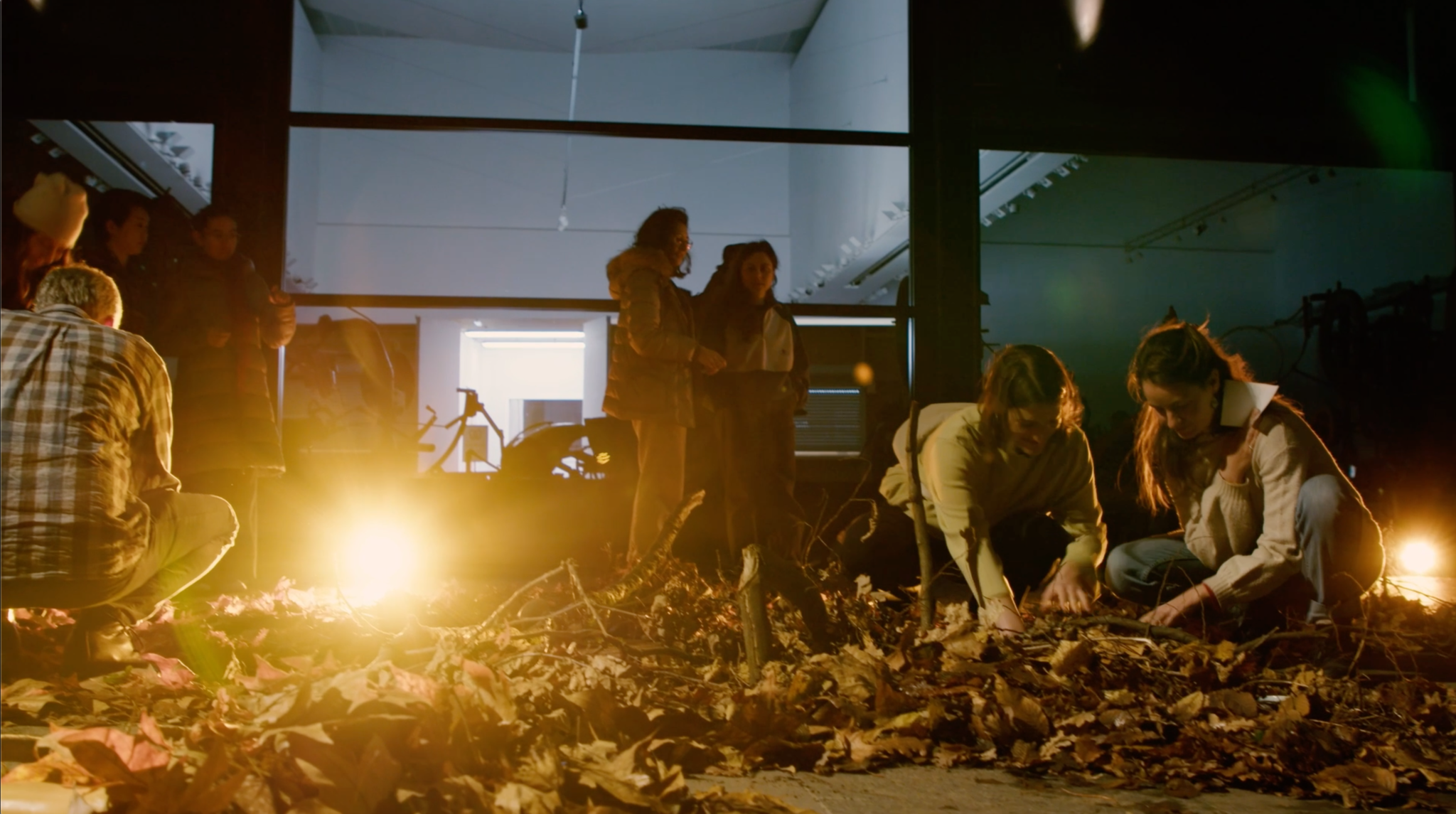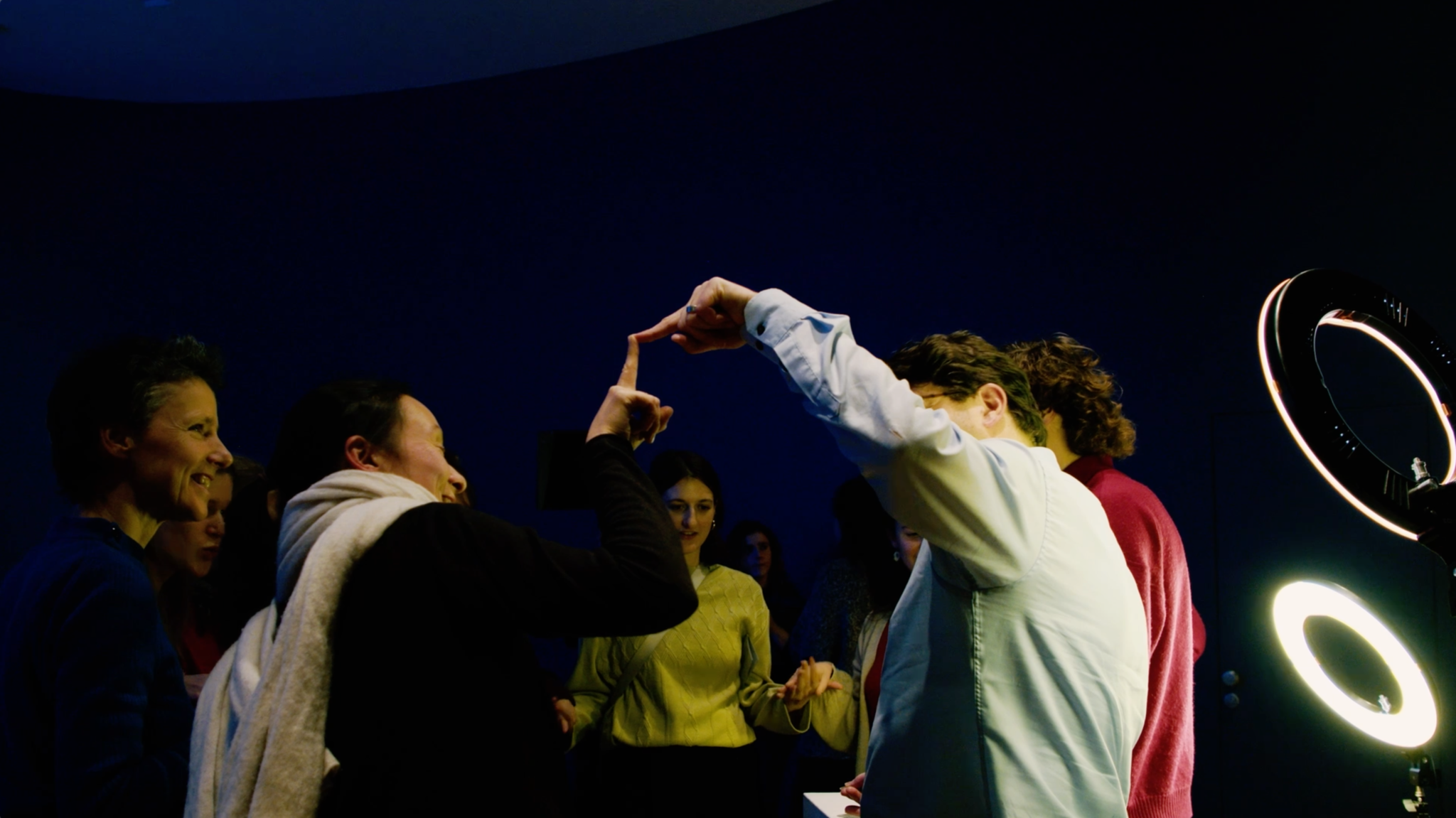Critical Insights and Mediation
A few critical questions arose during our research process, such as the relationship between process and product in artistic endeavors entailing embodied practices. A primary challenge lied in bridging the gap between our research and work into community building—in-group and external communities of humans and more-than-humans—and the practical production of materials, their content and making them available and relevant for a broader audience, so that the social and personal impact corresponds to the “worlding” potential of our research.
As a result of our work in the Witness Openlab, we laid a solid foundation for the development of new collaborative art projects. These projects were relevant to only to the immediate community of the Openlab participants but aiming at the broader communities we were engaging with, both in Basel and beyond. In this context, we consider how the embodied approach can be extended to a broader audience, particularly through our presentation format at the Tinguely Museum Basel in December 2023. We aimed to engage the audience physically, creating an immersive experience that mirrors our collaborative processes. Some specific stategies included:
-
Installation walkthrough: We guided the audience through the installation outside the museum, allowing them to sense various tangible organic materials and deepen their connection to the work prepared by the Soil Group (Fig. 4).
-
Listening to the body: Participants were encouraged to listen to their own bodies, focusing on their bellies and gut biomes as a micro-universe, fostering a personal and introspective experience.
-
Interactive Playtronica: The Playtronica TouchMe is a compact bio‑electric MIDI controller that turns human skin, water, flowers—or any conductive surface—into a musical instrument by converting the intensity and area of touch into variable pitch and expressive sound. We programmed this device to play bits of recordings and interviews we did within the community of the transborder area of Basel as a musical piece. This facilitated a shared musical experience that invited audience interaction and creativity. The device could only be made to function and create a field composition by forming a human circuit, connecting the two poles of the gadget (Fig. 5).
-
Experiencing the bridge: We offered the audience the possibility to experience the Three-Countries-Bridge and its profound meaning for the community around it with their own bodies, by building a multisensorial installation with air mattresses and a subwoofer (for the sense of movement and balance of the bridge), headphones and video projection, rendering field recordings and videos that we did on the bridge (Fig. 6).
-
Recreating with the audience our ritualistic end-of-the-day Otzkare Samadeshta salutation: Each day of the project, after practice and research, we gathered in a circle, holding hands and performing Otzkare Samadestha, a ritualic salutation that Julie Beauvais shared with us, with the aim of fostering unity, connection, and shared experiences. It invoked a sense of communal embodiment and cooperation, acknowledging out deep engagement with one another and the environment around us. We decided to perform the salutation at the end of the event, inviting all the participants to join the circle: researchers, audience members, museum staff.
All these practices mirrored the collaborative processes of the artists and deepened audience involvement, translating embodied collaboration into a public, experiential format. It served to break down barriers between artist-researchers and participants, creating a shared space for exploration and expression.
The presentational format of the event offered only a window into our research practice, without any further contextual grounding. Emphasizing bodily participation—through movement, deep listening, or sensory engagement—offers a pathway for individuals to experience the world differently, potentially catalyzing shifts in attitudes and actions toward social and environmental issues. However, relying predominantly on bodily engagement could limit the depth of awareness, potentially constraining participants’ understanding to immediate experience without fully exploring systemic or abstract dimensions of social and environmental issues.
This critique highlights the limitations of privileging embodied practices as the primary means of engaging with environmental and social issues. While somatic approaches can generate meaningful personal experiences, they risk three key problems: first, the aestheticization of ecological connection, where beautiful sensory experiences substitute for deeper engagement with environmental realities; second, the assumption that individual experiences automatically translate to systemic change; and third, the potential to overlook the complex political, economic, and scientific dimensions that shape environmental and social challenges. But instead of dismissing embodiment entirely, this analysis suggests that somatic practices are most effective when integrated with other forms of knowledge and action, avoiding the trap of treating personal experience as sufficient for addressing structural issues that require broader forms of understanding and intervention.
Conclusion
In summary, the Witness Openlab underscores the pivotal role of embodiment in reshaping our understanding of ecological and social interconnectedness. By centering the body as a primary medium for engagement, the project invited participants to experience the world not merely as passive observers but as active co-creators of meaning and awareness.
The Urban Witnesses and Soil Witnesses projects illustrated how embodiment serves as a vital tool for exploring complex relationships and narratives of identity, community, and biodiversity. By immersing ourselves physically in diverse contexts—whether navigating the trans-border areas of Basel or engaging with the rich ecosystems of urban gardens—participants embodied the interconnectedness that defines our shared existence. Despite integrating a theoretical and critical approach to hands-on practice, this experiential research methodology shifted the focus from abstract concepts to lived experiences, emphasizing that understanding ecological relationships requires a sensorial and relational engagement with the world, that simultaneously reinforces and is reinforced by ongoing critical thought, theoretical frameworks and education.
References
- Goldman, Aura. 2024. What on Earth is Eco-Somatics? April 16, 2024. https://auragoldman.co.uk/what-on-earth-is-eco-somatics/ (accessed 31 Jul 2025).
- Haraway, Donna J. 2016. Staying with the Trouble: Making Kin in the Chthulucene. Durham: Duke University Press.
- Haraway, Donna J. 2008. When Species Meet. Minneapolis: University of Minnesota Press.
- Heidegger, Martin. 1962. Being and Time. Translated by John Macquarrie and Edward Robinson. New York: Harper & Row.
- Hutchins, Edwin. 1995. Cognition in the Wild. Cambridge, MA: MIT Press.
- Margulis, Lynn. 1981. Symbiosis in Cell Evolution: Life and Its Environment on the Early Earth. San Francisco: W.H. Freeman.
- Merleau-Ponty, Maurice. 2012. Phenomenology of Perception. Translated by Donald A. Landes. New York: Routledge.
- Oliveros, Pauline. 1974a. “Native”. In Sonic Meditations. Baltimore: Smith Publications.
- Oliveros, Pauline. 1974b. “Environmental Dialogue”. In Sonic Meditations. Baltimore: Smith Publications.
- Oliveros, Pauline. 2005. Deep Listening: A Composer’s Sound Practice. New York: iUniverse.
- Oliveros, Pauline. 2013. “The Witness. A Solo Duet with an Imaginary Partner, a Duo, or an Ensemble”. In Anthology of Text Scores. Edited by Samuel Golter and Lawton Hall. Kingston, NY 1240: Deep Listening Publications.
- Rogers, Yvonne, and Paul Hazlewood. 2008. “Research in Distributed Cognition: Challenges and Opportunities.” Human-Computer Interaction 23, no. 1: 1–20.
- Varela, Francisco J., Evan Thompson, and Eleanor Rosch. 1991. The Embodied Mind: Cognitive Science and Human Experience. Cambridge, MA: MIT Press.


